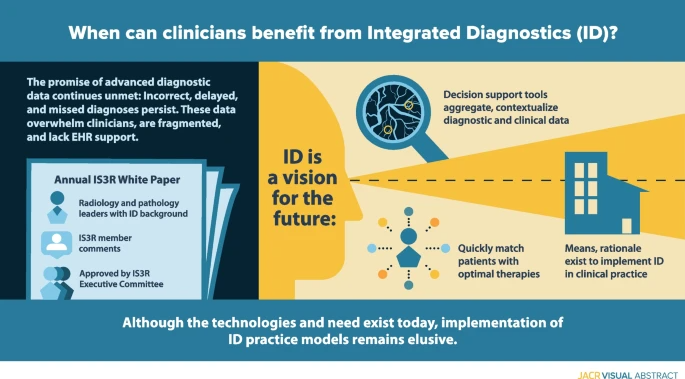Journal:Integrative diagnostics: The time is now—a report from the International Society for Strategic Studies in Radiology
| Full article title | Integrative diagnostics: The time is now—a report from the International Society for Strategic Studies in Radiology |
|---|---|
| Journal | Insights into Imaging |
| Author(s) | Beauchamp, Norman J.; Bryan R. Nick; Bui, Marilyn M.; Krestin, Gabriel P.; McGinty, Geraldine B.; Meltzer, Carolyn C.; Neumaier, Michael |
| Author affiliation(s) | Michigan State University, University of Pennsylvania, Moffitt Cancer Center and Research Institute, University Medical Center Rotterdam, Weill Cornell Medicine, University of Southern California, University of Heidelberg |
| Primary contact | Email: robert dot bryan at pennmedicine dot upenn dot edu |
| Year published | 2022 |
| Volume and issue | 14 |
| Article # | 54 |
| DOI | 10.1186/s13244-023-01379-9 |
| ISSN | 1869-4101 |
| Distribution license | Creative Commons Attribution 4.0 International |
| Website | https://insightsimaging.springeropen.com/articles/10.1186/s13244-023-01379-9 |
| Download | https://insightsimaging.springeropen.com/counter/pdf/10.1186/s13244-023-01379-9.pdf (PDF) |
|
|
This article should be considered a work in progress and incomplete. Consider this article incomplete until this notice is removed. |
Abstract
Enormous recent progress in diagnostic testing can enable more accurate diagnosis and improved clinical outcomes. Yet these tests are increasingly challenging and frustrating; the volume and diversity of results may overwhelm the diagnostic acumen of even the most dedicated and experienced clinician. Because they are gathered and processed within the “silo” of each diagnostic discipline, diagnostic data are fragmented, and the electronic health record (EHR) does little to synthesize new and existing data into usable information. Therefore, despite great promise, diagnoses may still be incorrect, delayed, or never made. Integrative diagnostics represents a vision for the future, wherein diagnostic data, together with clinical data from the EHR, are aggregated and contextualized by informatics tools to direct clinical action. Integrative diagnostics has the potential to identify correct therapies more quickly, modify treatment when appropriate, and terminate treatment when not effective, ultimately decreasing morbidity, improving outcomes, and avoiding unnecessary costs. Radiology, laboratory medicine, and pathology already play major roles in medical diagnostics. Our specialties can increase the value of our examinations by taking a holistic approach to their selection, interpretation, and application to the patient’s care pathway. We have the means and rationale to incorporate integrative diagnostics into our specialties and guide its implementation in clinical practice.
The following overall points can be made about this research:
- Although an overall boon to clinical diagnosis, increasingly voluminous, diverse, and fragmented diagnostic data can overwhelm physicians and frustrate patients.
- Data are gathered and processed within “silos” of the diagnostic disciplines, including radiology and pathology. The EHR does little to intelligently organize and synthesize these disparate data to facilitate diagnosis.
- Integrative diagnostics envisions a process in which data from the entire arsenal of in vivo and in vitro diagnostics, together with clinical data from the EHR, are aggregated and contextualized to enhance diagnosis and direct clinical action.
Keywords: diagnostics, integrative diagnostics, radiology, pathology, informatics
Background
Notes
This presentation is faithful to the original, with only a few minor changes to presentation, grammar, and punctuation. In some cases important information was missing from the references, and that information was added.










